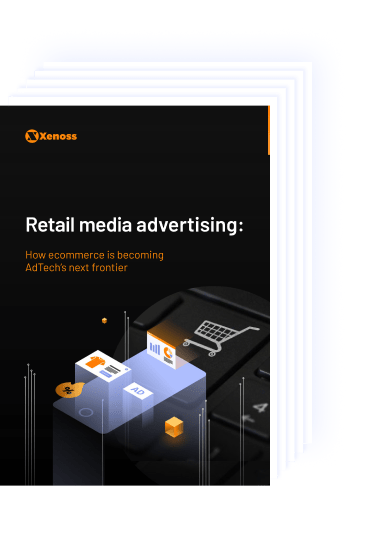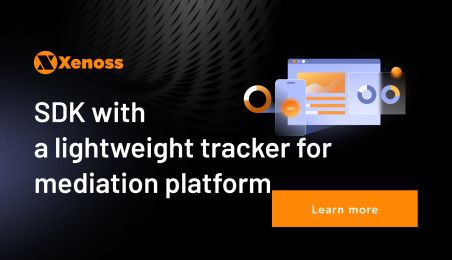Digital out-of-home (DOOH) advertising is one of the fastest-growing traditional media channels. By 2029, DOOH spending in the US is set to reach $18.6 billion. By 2030, the sector is projected to reach a 14.8% growth rate.
What draws brands to programmatic DOOH?
In short, advertisers are interested in high-precision targeting and clear-cut ROI for a broadcast reach of digital out-of-home. For years, teams struggled to measure the effectiveness of out-of-home ads and attribute positive lifts in key metrics to such campaigns.
Programmatic DOOH solutions solve this problem by bringing the advertising experience closer to audience-driven buying of digital ads.
In this post, we unpack:
- DOOH meaning for the advertising industry (and the big hopes behind it!)
- How programmatic DOOH works and what features DOOH systems have
- Why now is the right time to develop programmatic DOOH products
- Unique tech challenges AdTechs have to account for
- Latest market trends and developments in the DOOH industry
What is DOOH?
Digital out-of-home advertising (DOOH) combines hardware and software technologies for displaying dynamic ads in public spaces.
Think your average billboard, but on an HD digital screen and updated in real-time, based on real-world conditions such as weather or audience demographics.
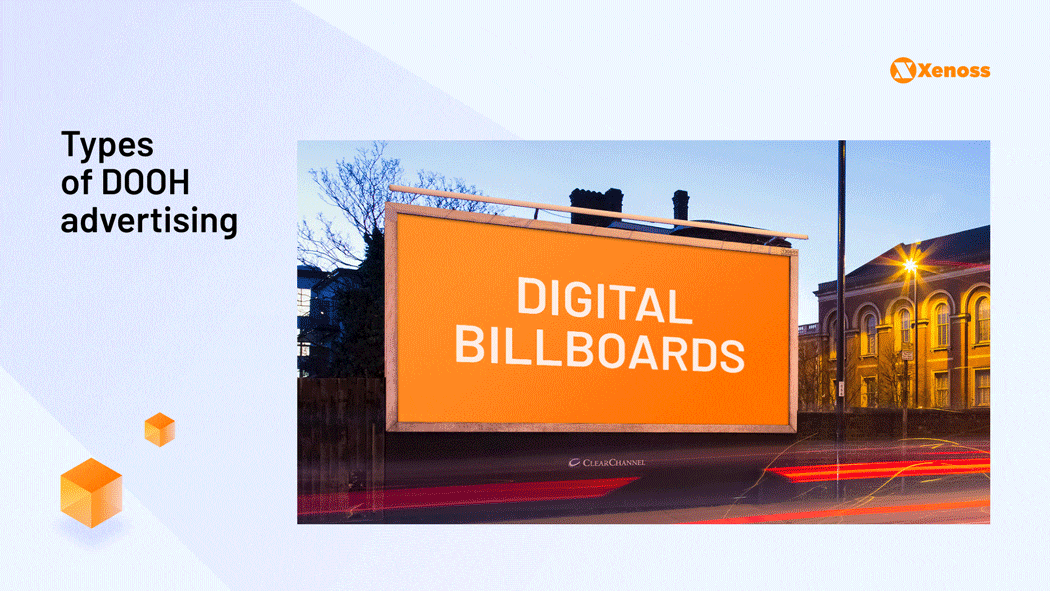
Digital OOH can be highly contextual and creative. You can run short video reels, create interactive consumer experiences, or personalize the ad based on current events — sports scores, traffic conditions, or even passing planes. DOOH ads can also be configured to generate collect customer data, measure viewer sentiment regarding your brand, or generate leads on the spot.
This translates to higher view rates, better brand recall, and follow-up actions.
I think marketers see digital OOH as a great alternative to reach people in the same hyper-relevant way as with digital, but in a channel that can’t be skipped or blocked.
Lauren Sak, Senior Marketing Director at Intersection
Due to the novelty of DOOH ads, consumers are more likely to engage with them.
In fact, 76% of DOOH viewers take action (watching videos, visiting promoted stores or restaurants) after interacting with the digital billboard.
Finally, DOOH can be programmatic. Innovative digital out-of-home advertising companies like Lamar and Broadsign allow brands to purchase out-of-home ads at selected locations and run them at fixed times. New market entrants are sizing up custom DOOH platform development, too.
Demand for programmatic DOOH is also on the rise. 32% of US advertisers rely on a combination of programmatic and manual buying, and 28% of surveyed respondents rely exclusively on programmatic campaigns.
Other benefits of programmatic DOOH include:
- Ability to run trigger-based buying campaigns
- Innovative ways to target consumers
- Higher brand recall and awareness
- A wider audience reach a lower cost
How programmatic DOOH works: Technical architecture overview
DOOH systems have two key elements:
- Connected hardware, often equipped with cameras and sensors.
- Software backend, featuring a combination of modules for dynamic ad displays, data capture, and subsequent data analysis.
A simple DOOH system can have these components:
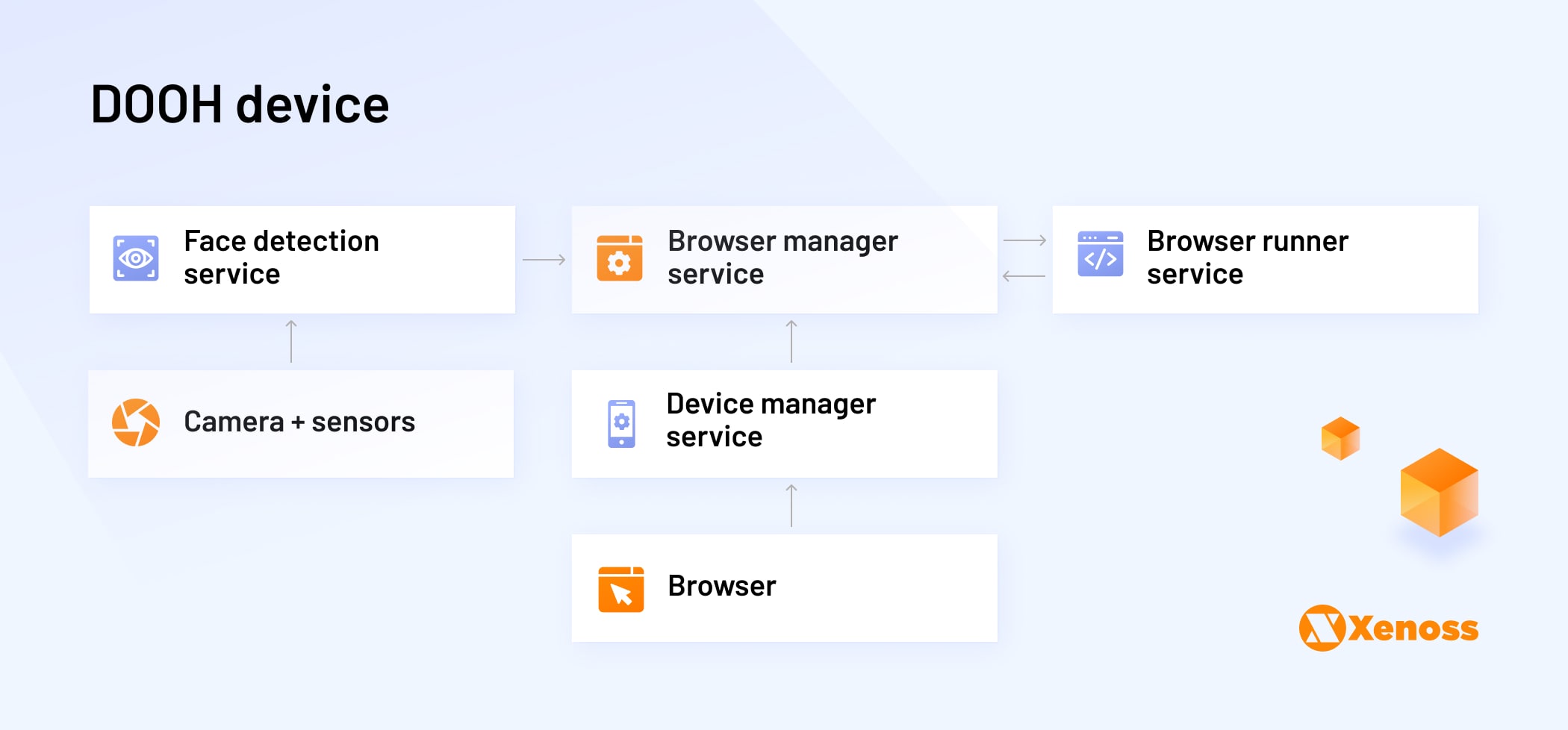
Such a device can be connected to a supply-side platform (SSP). The DOOH SSP, in turn, proposes the available inventory to a demand-side platform (DSP), where advertisers can place real-time bids on available inventory. Essentially, you get the same programmatic ad buying experience as for digital ads — but you purchase placements in the physical world.
The latest versions of DOOH devices also come with extra capabilities.
Environment recognition
A DOOH device can be equipped with multiple sensors:
- Temperature gauges
- Accelerometers
- Air quality sensors
- Motion sensors
These sensors can be used to create contextual ads and trigger-based buying campaigns, which fuse physical and digital realms.
For instance, as part of the “Magic of Flying” campaign, British Airways installed a digital billboard in London, equipped with an ADSB antenna. Each time a BA plane flew over the area, the billboard automatically displayed an ad, synchronized to the flight path of the plane. Such creative dynamic content significantly enhanced viewer engagement with the ad and improved brand recall.
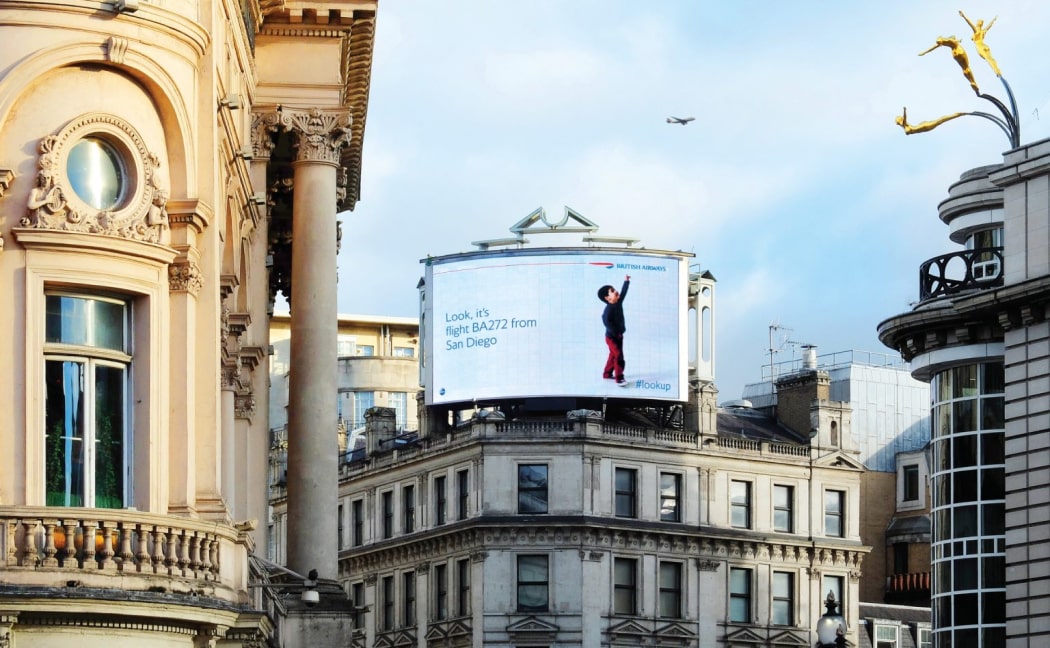
Measuring foot traffic
Lack of measurability often deters advertisers from OOH. Programmatic DOOH changes that. You can know how many people had the potential to view your ad. You can also analyze how popular each area is to estimate the possible ad impression count.
There are different methods for measuring foot traffic next to DOOH devices:
- Smartphone counts
- Infrared (IR) sensor counts
- Using pressure sensors
- By combining sensing technology with computer vision
CityTraffic, a creation of The Netherlands company Bureau RMC, conducted foot traffic measurements in some 620 European cities, across 600 shopping streets and 110 events with high precision and with all privacy considerations.
They use a combination of the stereoscopy-based scanner, infrared sensors, mobile device MAC addresses sensor, and a mobility viewer device equipped with computer vision. This combo allows them to measure unique footfall at different locations. Many DOOH inventory providers rely on a similar approach for foot traffic measurement.
Motion and gesture detection
The latest DOOH systems include a camera connected to a computer vision system. Such a setup lets you collect non-personally identifiable audience data such as age, gender, or facial expression attributes. You can also use motion detection systems to active ad showings and deliver an immersive brand experience.
British energy company E.ON used Ocean Outdoor’s network of digital out-of-home screens in Manchester and Birmingham to create a socially conscious “Let’s clean the air campaign.”
Each screen live-streamed the person within the detection range and the amount of pollution they were breathing in at the moment (using real-time data). Messaging changed depending on the pollution levels. The campaign attracted over 2,500 U.K. residents in one weekend and drove a positive lift in brand perception.
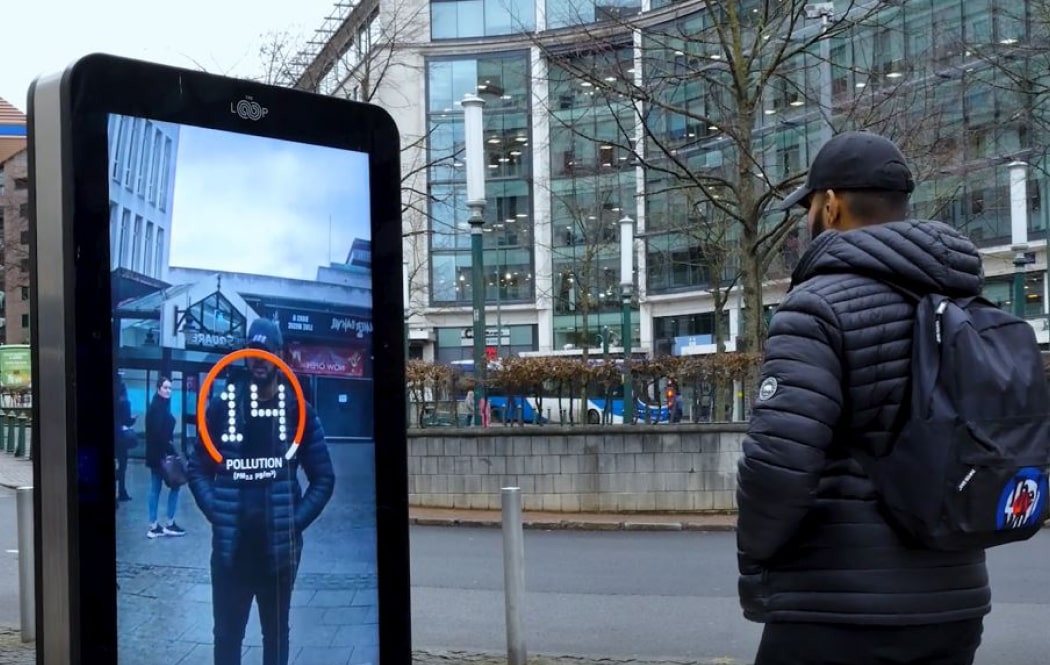
Geo-targeting and retargeting capabilities
Sensor-based DOOH systems can also process location data for retargeting. For example, you can track the number of Bluetooth-enabled devices in the area or tag users by their phone’s MAC address. Then supply this data to advertisers for optimized targeting.
Hivestack — a full-stack programmatic digital out-of-home platform — helped Mazda create a high-precision geo campaign built around custom audiences. Using available geofencing and mobile IDs data collected by DOOH devices, Hivestack pointed Mazda towards the optimal DOOH locations for running their ads. Then the Mazda team programmatically bid on open RTB ad impressions from DOOH SSPs, buying inventory that meets their custom audience criteria.
As a result of this campaign Mazda enjoyed a:
- 21% lift in aided ad recall
- 24% lift in brand perception
- 3% lift in brand behavior
Interactive elements
DOOH systems are more than “big screens.” They have connected devices with computing and data processing capabilities. Therefore, advertisers can easily integrate third-party data into their campaigns to make them more interactive and personalized.
DOOH software platforms can process:
- Point of sale data
- Social media feeds
- Weather data
- Sports scores
- Pollution levels
- Traffic data
…and other third-party insights, obtained from data brokers.
In a recent DOOH campaign, Skoda used location and live traffic data to show passersby how long it would take them to drive to one of the U.K.’s beautiful holiday destinations. For an automotive company, that was a refreshing take on advertising. Instead of promoting the technical characteristics of their new SUV, Skoda chose to focus on the “lifestyle aspect” of car ownership. And that landed well with their target audience — families.
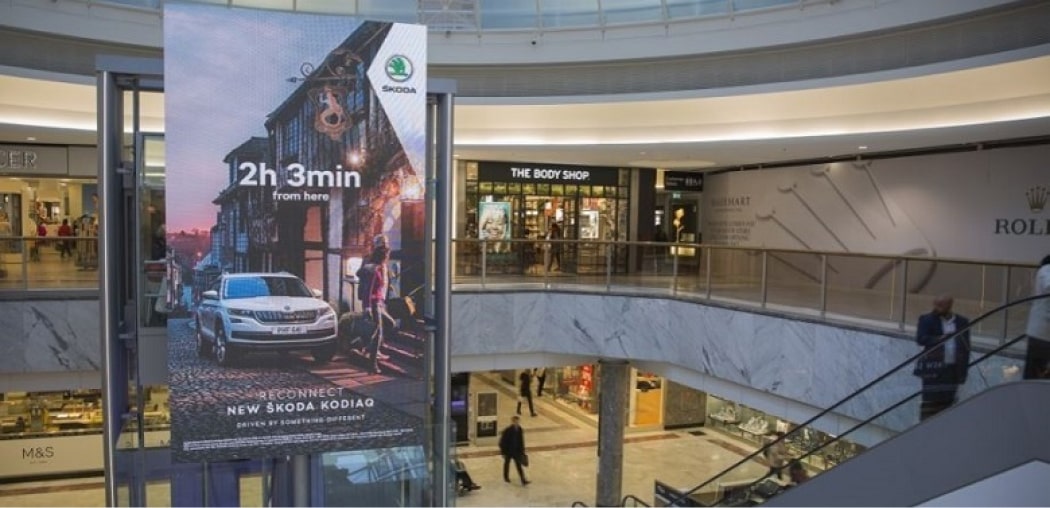
Interactivity also lends extra engagement to DOOH ads. An Ultraleap study found that compared to static DOOH, dynamic DOOH ads have 21% longer dwell time and result in 2X more conversions. Also, viewers spend 50% more time viewing the ad, and they are 52% more effective in increasing brand awareness.
Why invest in the development of programmatic DOOH products
Brands are intrigued with the new omnichannel customer targeting possibilities of DOOH.
According to an Alfi study, 96% of senior advertising executives believe DOOH data can improve campaign creativity and allow brands to leverage even more granular targeting.
Not only are brands now able to utilize the same audience data across channels for targeting and activation, but the increased flexibility means that mid-campaign optimization can now be applied to DOOH. For example, the best locations for driving in-store traffic or mobile downloads can be upweighted at the click of a button, and advertisers can see the impact of each media within the campaign mix and adjust accordingly.
Here are five solid reasons to add programmatic DOOH to your AdTech software development roadmap. Larger advertisers are looking for high-precision targeting, transparent reporting, and creative campaign styles. Programmatic DOOH ticks all of these boxes — and lets you optimize your operating margins too.
Advanced attribution
Programmatic DOOH lets you match device-collected data with audience insights from third-party attribution vendors to provide more precise targeting. A comprehensive data ecosystem allows advertisers to run high-performance omnichannel campaigns with DOOH in the mix.
Pepsi Max recently hosted a series of tasting challenges in malls. To retarget those prospects, they logged a unique ID of each participant using beacon technology. Then when one of the tasters entered a mall, Pepsi automatically triggered programmatic DOOH ads on screens. Clever and effective.
Data-rich inventory
DOOH can provide media buyers with rich data on each inventory asset — from average foot traffic to average viewability or ad interaction rates. This makes inventory more appealing to brands — and more profitable for DOOH system owners.
With DOOH, advertisers can purchase ad units in locations most popular with their target audience, perform advanced segmentation, or run sequential ad campaigns across channels. For example, target transit passengers with mobile ads first. Then retarget them with a related ad on a digital screen at their final destination.
Nestlé Purina, for example, leveraged data from Otto Retail to target the audience of cat owners. Based on this first-party data, they’ve selected optimal DOOH ad placements and the best time to display them. Simultaneously, they targeted this audience via online radio channels. The campaign was executed programmatically, which allowed Nestle to boost impression count by 13% without increasing the budget.
Predictive modeling
AdOps teams can further increase the precision with which DOOH captures customers at the point of maximum possible engagement once they embed predictive analytics into the DOOH stack.
Identifying engagement patterns helps media buyers estimate:
- Which locations will yield higher engagement
- What time is optimal for capturing more ready-to-buy passerbyers
- Which ad spend should the team allocate to the campaign
For DOOH vendors, expanding their offerings with predictive analytics helps retain partners and scale their impact in the client’s ad spend.
For example, after a successful DOOH campaign for Anytime Fitness, Vistar Media successfully used collected data to plan the second flight that captured a higher number of relevant venues and generated a 15% increase in sign-up intent compared to the first campaign.

Better ad experience
“Banner blindness” and high usage of ad-blocking software render digital ads less effective. Likewise, many standard digital ad formats don’t allow creating immersive viewing experiences (except for in-game advertising and native ad placements).
DOOH ads, on the other hand, can bridge the physical and digital worlds. The ad creative can be updated dynamically to be more personalized and memorable. DOOH can tie ad messaging to real-time events — weather conditions, the latest game scores, or the number of cars in the area.
For instance, Sea-Doo managed to get an 80% lift in purchase intent after running a weather-based DOOH campaign. Using Foursquare’s audience and POI targeting, the watercraft seller ran ads across several key US locations with dynamic messaging, suggesting that a cloudy day shouldn’t deter you from taking a boat ride.
Easier ad rotation
Unlike standard OOH, you don’t need to change any marketing collateral once the campaign period expires. Programmatic execution lets you rapidly switch between campaigns moments after the impressions were delivered, lowering your management costs and increasing profit margins.
Better pricing dynamics
Instead of entering fixed-price agreements with advertisers, you can run real-time auctions based on OpenRTB standards. Brands can bid on available DOOH inventory and snatch the best deals for the lowest price. Or settle for the next-best option.
This allows you to adjust pricing to the current supply and demand dynamically. At the same time, DOOH owners will get higher fill rates. You can also set up your AdTech platform to support programmatic guaranteed deals or private marketplace advertising deals to retain loyal brands.
Synthetic audiences
Now that the regulations around collecting deterministic user-level data are getting tighter, brands and AdTech vendors are increasingly tapping into synthetic data capabilities.
With generative AI and predictive analytics, DOOH vendors can build audience segments that match the age, income, interests, habits, and movement patterns of real-world audiences. Media buying teams can use their understanding of this traffic to plan campaigns, collect data, and onboard new screens more effectively.
MOVE, an Australia-based DOOH audience measurement company, is already tapping synthetic audiences to help brands better understand local consumers. Its AI-augmented dataset accurately represents 2 million Australians over 14 years old, which is approximately 10% of the country’s population. Based on audience data, MOVE helps brands simulate the moving patterns of target customers and build detailed demographic profiles.
The company’s data modeling technologies reliably support DOOH market leaders, including JCDecaux, Metrospance Outdoor Advertising, APN Outdoor, QMS, and many others.
Hence, for an AdTech vendor, rolling out proprietary synthetic data capabilities can become a powerful differentiation point that helps both attract brand demand and build industry partnerships.
Tech challenges of DOOH
DOOH advertising solutions development requires knowledge of both hardware and software components of the ecosystem. Hardware market fragmentation alone can pose major roadblocks.
Since it’s a new channel, DOOH also has fewer technological standards for programmatic ad serving. At the same time, you also must account for new data types and unique creative formats.
But these shouldn’t phase you, especially if you are working with an experienced AdTech development partner.
Measuring ad viewability
To deliver effective measurement, DOOH devices have to be equipped with HD cameras and robust computer vision systems (which are complex to develop in the first place). This tech combo ensures proper rendering of the environment and ad viewability measurement.
But here’s where things get tricky: You also have physical device constraints. DOOH ads may not be easily visible from every angle. Likewise, it would be best if you minimized passerby double-counts.
OAAA attempts to address DOOH ad measurability issues with set guidelines and best practices. To accurately calculate viewability, they suggest factoring in:
- Distance between the user and DOOH display (varies by venue and device type)
- Latitude and longitude coordinates of the screen
- Average dwell time, based on the consumer’s proximity to the screen
- Cardinal direction that a screen faces
To deliver accurate reporting to buyers, you must capture and analyze a host of new input variables for different types of inventory. The Frankfurt airport employs an innovative DOOH measurement solution, designed by leading global specialists from JCDecaux and Veltys specifically for airports worldwide:
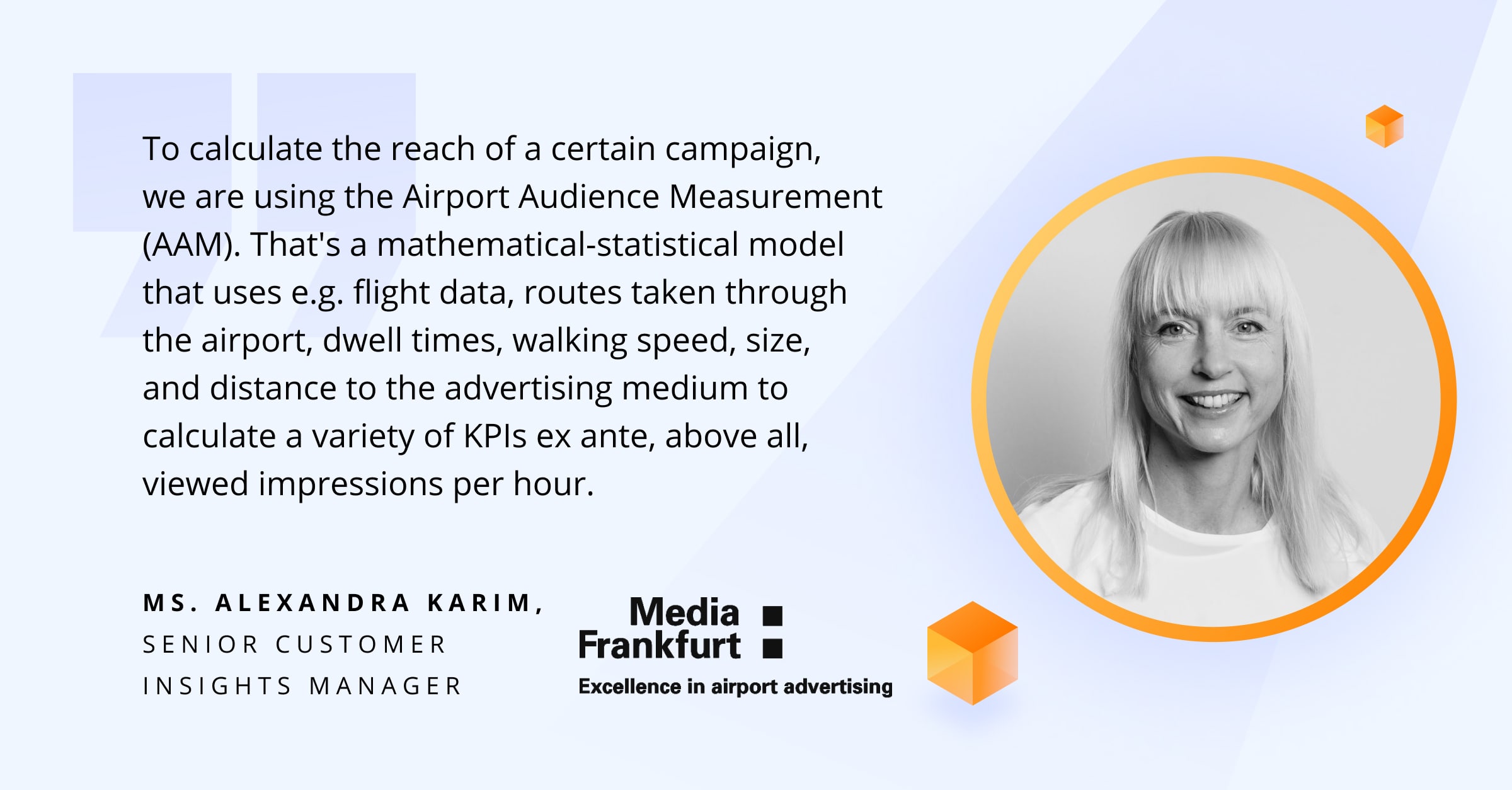
Nonstandard creative formats
DOOH screens come in different shapes and sizes. If you plan to add a DOOH asset to your inventory, you should verify that it can serve ads in adaptive HTML5 format. HTML5 allows advertisers to quickly adapt their content from other channels (mobile, web) to DOOH campaigns.
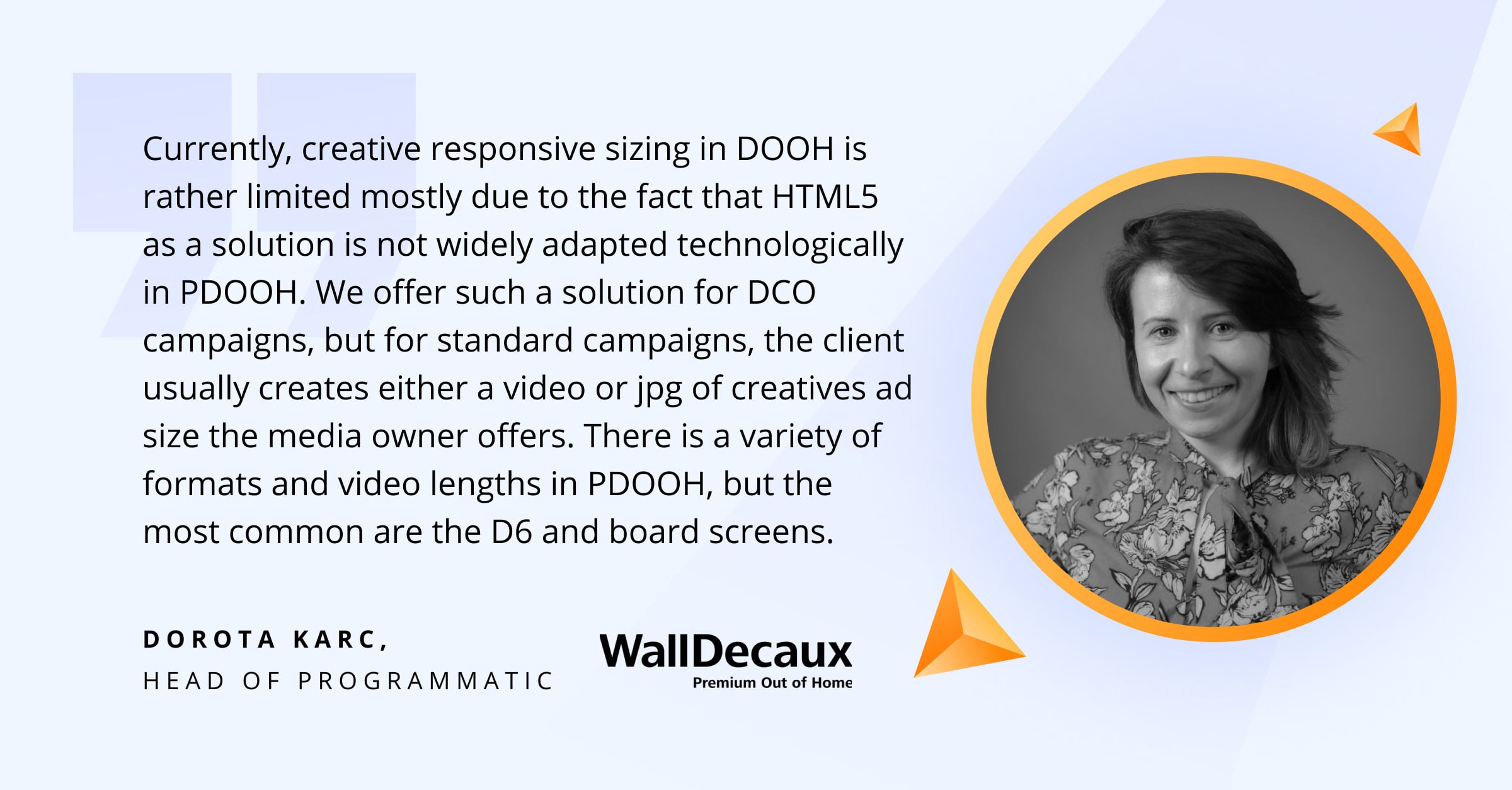
If you plan to sell video DOOH ads, pay attention to content length. The creative has to be short, 5-10 seconds long. Serving video DOOH ads of widely different lengths can mess up your broadcast scheduling. Some DOOH devices can incorrectly display too short or too long playouts.
The Digital Media Institute (DMI) released recommended specs for video and visual DOOH campaigns. You can (and should) make these part of your requirements for content.
Real-time data
The ability to tailor creatives to real-time traffic, weather, or sensor data is a major part of the DOOH appeal, and it is a non-trivial technical challenge.
Brands and DOOH companies also have to carefully navigate privacy challenges around real-time data collection.
30Seconds Group, a UK-based digital billboard company, faced backlash for using face-tracking cameras to monitor how apartment block residents respond to ads. One of such residents voiced concerns about an AdTech company spying on him in a comment for The Guardian.
RMG says I’m not being spied on, but there are cameras in the devices; you can see them. Even if it was at zero cost to residents, I would still fight these tooth and nail, nobody wants to be spied on by 6ft garbage adverts in their own building.
To avoid public scrutiny, DOOH vendors need to look for alternative data collection tools – live feeds, mobile SDK location data, on-site sensors, QR codes, or Bluetooth.
But, even with a pool of reliable data sources, building a data pipeline that will both display a personalized creative in under 100 milliseconds and scale to serve millions of impressions (this is the scale at which market leaders like Vistar operate) requires strong in-house data engineering capabilities.
When committing to building a pDOOH platform, make sure to select vendors with a proven track record in four areas.
- Designing a pipeline that supports both batch and streaming processing
- Enforcing data quality gates to prevent false or irrelevant data from triggering ad display
- Setting up low-latency integrations with other AdTech intermediaries (DSPs, SSPs, CDPs, and CMPs)
- Building an error-proof creative optimization and content delivery engine.
Working with a team that understands the nuances of low-latency, high-scale architecture of pDOOH solutions will help protect data security and avoid display errors that dissipate brands’ ad spend.
Hardware limitations
DOOH systems have become more advanced. But there are still some inherent hardware limitations. By design, not all systems allow establishing proper programmatic ad serving. You will need to create a prescreening mechanism for media owners to accept only suitable suppliers to your ecosystem.
For example, the DOOH device must have sufficient CPU, GPU, RAM, and storage to display HD content correctly. Also, it should support video codecs your platform can process and have all the needed connectivity options — WiFi, Bluetooth, 4G/5G, etc.
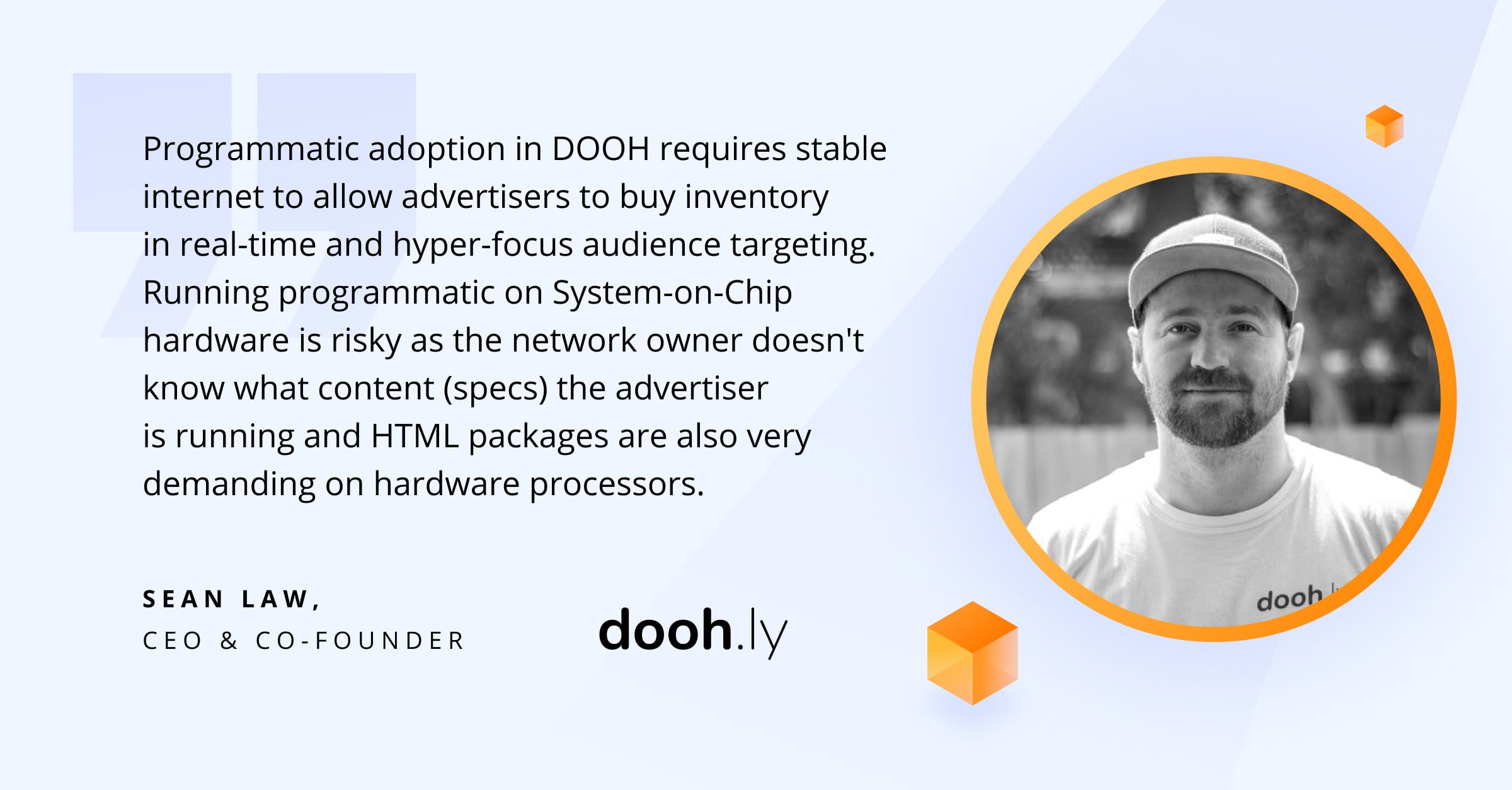
The digital screens market is highly fragmented, so it’s best to decide on some limitations instead of trying to optimize your platform for every type of device.
Proper targeting and attribution
Interactive DOOH systems process data in multiple formats — camera video, sensor data, Bluetooth-enabled devices capture, and data from third-party providers. These data points are necessary for high-precision targeting and attribution.
To ensure proper tracking and analytics, you need to develop a secure, high-load data management platform. Any glitches or inconsistencies can undermine the credibility of your DOOH measurement and reporting. Rapid data matching and processing are also crucial to avoiding lags in ad delivery and targeting efficiency.
Vova Kyrychenko, CTO at Xenoss
Integrating DOOH inventory into programmatic platforms
The advertising industry has yet to rule on clear-cut standards around movement, ad play, and venue data, which are necessary to establish ad viewability.
The data variables themselves can tell conflicting stories. For example, the direction that the outdoor screen is facing can help validate the travel direction of a mobile device. But it’s a less relevant metric for indoor displays as passersby can pedal back to look at the ad. But not all DOOH hardware can provide this information.
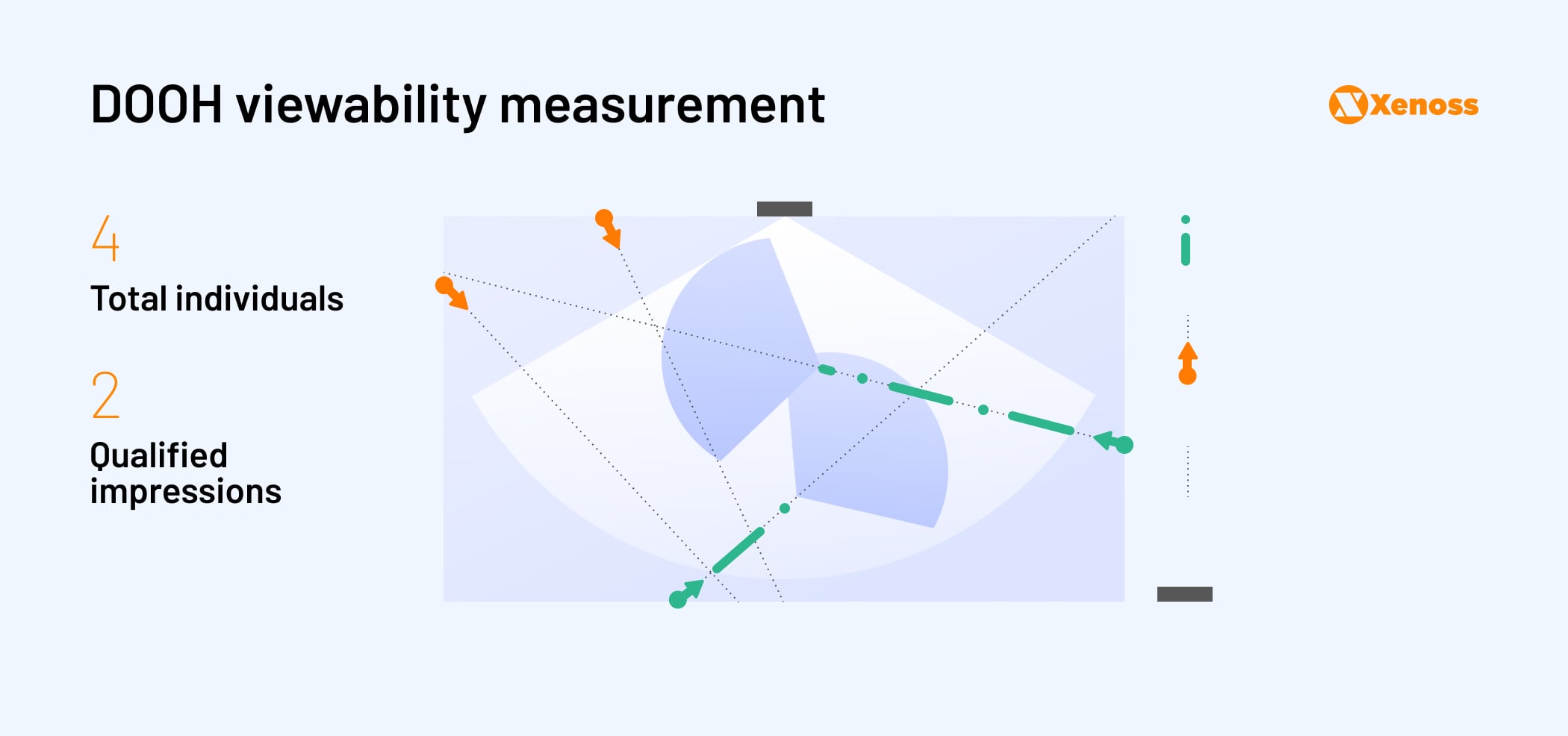
When it comes to programmatic DOOH buying, there’s also no consensus on which data points DSPs and SSPs should exchange. Many platforms fail to factor in the unique characteristics of place-based advertising, such as:
- One-to-many vs. one-to-one impression delivery
- Extra latency in ad delivery for larger creatives
- Pixels for video tracking won’t work as an accurate measurement
The Digital Place-Based Advertising Association (DPAA) developed a framework for programmatic DOOH based on the OpenRTB 2.5 protocols. But with adjustments, accounting for the unique requirements of DOOH ads.
Privacy considerations
DOOH devices can collect more user data — from location to demographics. But requirements around user consent for such data collection vary by country.
Consumer privacy regulations such as GDPR and CCPA set rigid standards for collecting, storing, processing, and disclosing customer information in the EU and the US. Because of these, DOOH providers cannot transfer live video from camera systems — and process only text-based attributes. That’s called anonymous video analytics.
Computer vision-based DOOH devices can only perform facial detection, not facial recognition. The device can scan the consumer’s expression, age, or gender but not directly ID them based on unique facial features. In fact, 54% of US consumers are opposed to advertisers using facial detection technology to measure their reactions to public ad displays.
But the sentiment is different in the East. China, for example, has more relaxed privacy regulations. Back in 2015, China’s postal service did a multi-city DOOH campaign, using displays that tracked the viewers’ eye movements and dwell time of each glance while also factoring in the “biometric signature of each individual.” The country also largely normalized the use of facial recognition technology in “cashless” stores and hotels where customers can check out using their faces.
Ubiquitous connectivity, a wide network of CCTVs, and the newest digital screen models have made China a booming DOOH market with advanced targeting options.

The state of DOOH market
In the US, DOOH ad spending is projected to reach $2.87 billion by 2027.
Much of the industry growth will come from a rapid programmatic DOOH expansion with RTB opportunities now becoming available via mainstream DSPs.
In 2018, JCDecaux — a global leader in outdoor advertising – launched a programmatic out-of-home trading platform (VIOOH). Since then, they’ve been adding thousands of new DOOH devices to their global network. VIOOH recently added Frankfurt Airport to its media portfolio. The fourth busiest airport in Europe implemented a DOOH system across 23km2 of its area.
Through VIOOH, advertisers can now access over 800 panels of Frankfurt Airport in 34 DSP via PMP. JCDecaux (VIOOH’s parent company) currently provides airports DOOH inventory programmatically across the US, EMEA, Asia, and Australia.
AdTech startups are also expanding into programmatic DOOH with the help of venture capital. In 2021, Place Exchange, a DOOH SSP platform, closed a $20 million Series A round. Vistar Media, an end-to-end programmatic platform, secured $30 million in a Series B the same year.
Overall, the DOOH market is merely entering the growth stage. Over the next two years, 95% of advertising executives expect the DOOH market to grow significantly and surpass $50-$55 billion by 2026.
Programmatic DOOH marketplaces
Entering the DOOH market now can still give you the “first mover” advantage and the ability to secure contracts with large brands before they select an alternative provider.
But you must move fast, as other AdTech players are already carving their initials in the markets.
DOOH DSPs
The following companies specialize exclusively in DOOH inventory or have extensive access to it:
|
DOOH SSPs
The following companies allow digital out-of-home media owners to list their inventory or leverage their own inventory:
Final thoughts
Programmatic DOOH is an uncharted new territory to conquer. It comes with a host of obstacles, mainly around data processing, ad viewability measurement, and low-latency ad creative processing. But those that resolve these issues will be well-positioned for upcoming growth.
Advertisers are looking to scale beyond private marketplace deals and programmatic guaranteed ad placements. Many also want to run dynamic, data-rich campaigns in locations frequented by their ideal targets. But few players deliver that type of end-to-end buying experience. Your company can fill in this gap.
Xenoss can help you with DOOH integration to your AdTech platform or develop a new DOOH DSP/SSP platform. Contact us to discuss your project.
